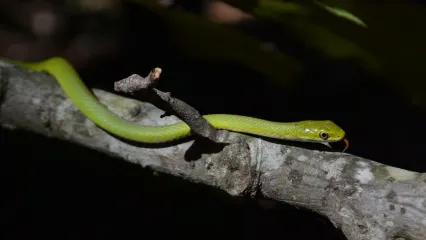
Description
The little brown skink can be distinguished from all other lizards in the region by a combination of its small size, smooth overlapping scales, fore- and hind limbs small relative to the body, and a small transparent disc in the eyelid. Other skinks in the area do not have this disc. Body color is gray, tan, or brown, with a single dark brown to black lateral stripe on each side extending from the snout to about the first one-third of the tail. This stripe is bordered below by a narrow tan or yellow stripe that begins just behind the eye. In older adults, the dark stripe may be broken up to some extent.
Size
Little brown skinks are the smallest lizards in Oklahoma, with adults reaching only about two and one-quarter inches in snout to vent length. The tail is about as long as the body.
Habitat
The little brown skink occurs through most of Oklahoma with the exception of the far western part. It is not in the Panhandle. In the western part of its Oklahoma distribution, it is restricted to riparian woodlands and canyons. In North America, the distribution extends west-east from southcentral Texas up the east coast to New Jersey and north-south from southern Illinois, Indiana, and Ohio to the southern tips of Florida and Texas.
Life Cycle
Little brown skinks can be active any month of the year if temperatures are warm enough. Most of their seasonal activity occurs from April through October. During cooler parts of the year, they can be active during mid-day, but during warmer parts of the year, their activity is restricted to morning and late afternoon. Most of their time is spent moving in and out of leaf litter in search of small insects. Mating occurs during spring. Individual females deposit two or more clutches varying in size from one to four eggs during May, June, July, and August. The number of eggs produced in any given clutch is determined largely by female body size. Females do not attend the nests as do other skinks in this genera. It is not uncommon to find large numbers of eggs in one nesting site; these sites are called communal nesting areas. Females deposit eggs in soft soil exposed to sun and often these nesting sites are limited in the shaded habitats in which the lizards live. Hatchlings, which are small (less than one inch in snout to vent length) appear in July, August, and September. These small lizards feed on tiny insects, spiders, millipedes, and earthworms. The tails of little brown skinks are extremely fragile, breaking very easily. This is an effective predator escape mechanism, and the lost tails regenerate so well that they look very much like the original tail. If tails are not eaten by predators, the skinks will often return and eat their own tails, thus regaining some of the energy lost.
How To Observe
These are common almost anywhere in which the ground is covered with leaf litter. They are most easily observed in morning or late afternoon by walking slowly and searching the surface of the leaf litter. When approached, they usually dive into the leaves, often leaving the tail tip exposed and moving as a distraction. They can be observed again as they emerge by waiting a few minutes and carefully watching the surrounding leaf litter.
(This profile was created by Dr. Laurie Vitt as part of a partnership between the Wildlife Department and the Sam Noble Oklahoma Museum of Natural History. It was funded as part of a larger State Wildlife Grant to survey and inventory amphibians and reptiles of the Wildlife Management Areas of Oklahoma: T-35-P-1.)


